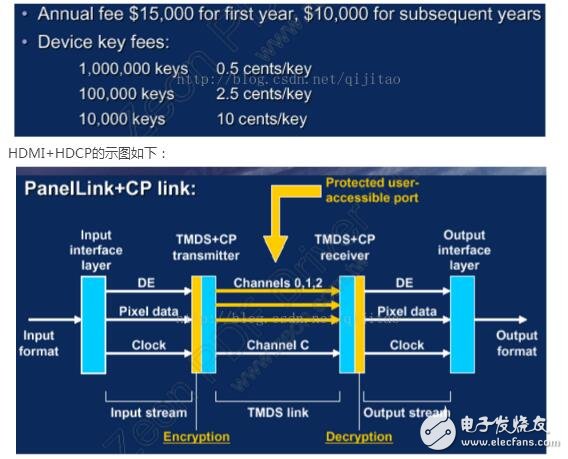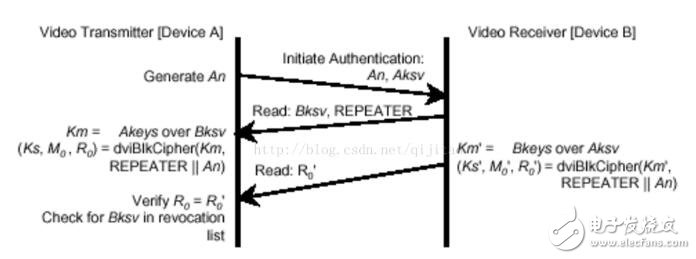HDCP (High-bandwidth Digital Content ProtecTIon): High-bandwidth digital content protection technology. The era of HDTV (HDTV) is coming, and in order to adapt to the high bandwidth of HDTV, HDMI has emerged. HDMI is a high-definition digital interface standard that provides high bandwidth and lossless transmission of digital video and audio signals. In order to ensure that high-definition signals transmitted by HDMI or DVI are not illegally recorded, HDCP technology has emerged. The HDCP specification is led by Intel. When the user makes an illegal copy, the technology interferes and reduces the quality of the copied image, thus protecting the content. Frankly speaking, although HDCP has received widespread attention in the industry, the popularity is a foregone conclusion. However, from the principle of HDCP, the protection process is too simple, only to achieve protection in the external transmission process, which is limited by the era of universal application of computers. This not only makes people feel that the developers have the suspicion of defrauding high licensing fees. Moreover, once the digital signal itself is read into the computer in binary mode, the copying process can still be implemented, and the RIP method similar to DVD DVD can be used for separation. HDCP protects video signals from beginning to end, which means that every part of the whole playback system must support HDCP. If the display does not support HDCP, then HD programs cannot be played normally, only black screen or low quality can be seen. Program. The basic principle of HDCP HDCP (High-bandwidth Digital Content ProtecTIon) is used for transmission protection of HDMI-enabled transmitters and HDMI-capable receivers. In order to protect copyright, it has been acquired by the motion picture industry (such as FOX, Universal, Warner Bros, etc.). It is based on HDMI, which transmits high-speed, high-bandwidth digital content protection. Other anti-copy technologies are not suitable for HDMI. For example, Macrovision is only suitable for analog signals. DCTP only supports 100~400M bandwidth, and only adapts to IEEE-1394. To get this technology and produce HDCP-enabled products, you must obtain a license from Digital Content ProtecTIon LLC to get the device key required for HDCP, which is unique, one device and one key. The payment of Licence is as follows: First, you must get HDCP acknowledgment (AuthenTIcation) to perform HDMI data transmission. The process is as follows: When the transmitting end and the receiving end get a valid device key from Digital Content Protection LLC, there will be a corresponding identifier (Identifier), ie KSV (Key Selection Vector Key Selection Vector). 1. Confirm initialization, a 64-bit pseudo-random sequence An is generated by the HDCP crypto engine of the transmitter A, together with its own KSV (Aksv), transmitted to the receiving end, the receiving end transmits its own KSV (Bksv) and REPEATER bit to the transmitting end to respond. 2. At the transmitting end, Akey and Bksv perform the algorithm to obtain Km, and then Km, REPEATER, and An get Ks, Mo, and R0. Similarly, the receiving end is algorithmized by Bkey and Aksv to obtain Km', and then Km, REPEATER, An to get Ks', Mo', Ro'. 3. When R0 = R0', the initial confirmation of HDCP passes. 4. In the future blanking period, starting from the 128th frame, every 2 seconds, Mi (initialization value, I want to be equivalent to the previous An) It becomes a new value to calculate the new Ri and Ri', which means that Ri and Ri' are upgraded every 2 seconds. 5 . When Ri= Ri', the HDCP confirmation is passed and the HDMI connection is continued. 1. HPD (Hot Plug Detect) is a method of detecting whether the receiver is connected, regardless of whether the receiver is powered. 2. EDID When it is detected that the receiving end is connected, the EDID information is read from the EEPROM of the receiving end, and the EDID (Extended Display Identification Data) is the display format of the EEPROM storage monitor at the receiving end, and the transmitting end (PC host) needs to read out EDID information to determine the format of the output. 3. Confirmation of HD CP Check whether the receiving end is powered on. 》 Establish HDMI connection 》 HDCP confirmation, retry three times 4. HDMI data transmission and decoding of TMDS.
The anti-glare technology used in the Matte Protective Film can reduce glare to eliminate eye fatigue, and make it easier to watch under direct light, which is more friendly to your eyes.
In order to let you enjoy it for a long time, the Frosted Screen Protector uses durable military-grade TPU material, which has strong durability and scratch resistance. It protects the screen from unnecessary scratches.
It has good anti-fingerprint ability, sweat will not remain on the screen surface, and it is easy to clean without affecting touch sensitivity or response speed.
The adhesive layer ensures that you stick the Protective Film in a stress-free manner and maintain a strong adhesion without leaving any sticky residue.
If you want to know more about Matte Screen Protector products, please click the product details to view the parameters, models, pictures, prices and other information about Matte Screen Protector.
Whether you are a group or an individual, we will try our best to provide you with accurate and comprehensive information about the Matte Screen Protector!
Matte Screen Protector, Frosted Screen Protector, Matt Screen Protector, Matte Hydrogel Film, Matt Protective Film, Anti-Glare Screen Protector Shenzhen Jianjiantong Technology Co., Ltd. , https://www.mct-sz.com


Introduction to HDCP
March 22, 2023